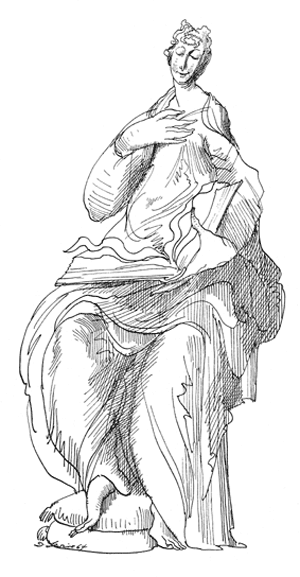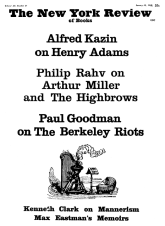Ever since the 1920s when Max Dvorak, the most inspiring teacher of his day, gave the term fresh currency, art historians have been debating the definition of the word mannerism. As usual in such debates there has been a division between expansionists and contractionists, enthusiasts and precisionists. On the one hand the word has been stretched to cover art and literature of every kind, from the fifteenth to the eighteenth century; on the other, as in recent careful studies by Craig Hugh Smyth and John Shearman, it has been restricted to a short episode in Roman and Florentine art of the sixteenth century. Jacques Bousquet, the author of this sumptuously illustrated volume, is a flagrant expansionist, partly from enthusiasm for his subject, partly, it must be admitted, from a lack of art-historical training. The subtitle of his work, The Painting and Style of the Late Renaissance, does not hold out great hopes of accurate classification. All is grist to his mill, and among the titles of the short chapters in which he defines the themes of mannerism are Perversion, Sadism, Melancholy, Crafts and Mechanical Inventions, Occultism, The Terrifying Image, and even The Love of all Things Good and Beautiful. Such inclusiveness involves a surprising chronological agility. He skips lightly from the fifteenth century to the eighteenth and on the same page (218) quotes both Marsilio Ficino and Milton as evidence of mannerist sentiment. The trouble is, I think, that he has not made up his mind whether mannerism should be regarded as a style with certain identifiable characteristics, or as a “spirit” which expresses itself in certain subjects. In the great artists of mannerism, as in all great art, style and spirit are one and indivisible; but many of the impulses, eroticism, sadism, curiosity, perversion, and so forth, which he claims as peculiar to mannerism, have been of recurring interest to human beings, and cannot be made the basis of an art-historical definition. A useful definition of mannerism must combine stylistic and historical analysis.
The style originated in Rome (although M. Bousquet repudiates this view) in about the year 1520. It grew partly out of the strange and compelling stylistic discoveries in portions of the Sistine ceiling, notably the spandrels with the miraculous Salvations of Israel, and some of the Ancestors of Christ; partly out of the elegant formulas in which Raphael’s pupils interpreted the later designs of their master. From these two sources flowed the two differing, although occasionally mingling, currents of mannerism, which may be called for convenience the expressionist and the decorative. The young artists who first fell under the spell of these works were extremely talented. The two Florentines, Rosso and Pontormo, the Sienese, Beccafumi, and the north Italian, Parmigiano, as well as two of Raphael’s pupils, Perino del Vaga and Giulio Romano, were as gifted as all but the greatest of the preceding generation. But they suffered from the spiritual exhaustion which comes at the close of a heroic age (a similar exhaustion had taken place after the death of Giotto), and could not allow their gifts to develop naturally. Those who derived from Michelangelo, like Pontormo and Rosso, exaggerated his emotional intensity to the point of hysteria; those who derived from Raphael exaggerated his elegant gestures to the point of inanity.
What they had in common was a love of serpentine movement—the typical mannerist pose is that of a man using his right hand to get the change out of his left hand pocket—and a feeling that art should be made out of art and not by direct reference to observation. Apart from Michelangelo and Raphael their repertoire of forms was largely drawn from antique reliefs, in particular those on the two columns and on a certain type of late sarcophagus. It is from these that they derived the flatness, the overcrowding and the profusion of angular arms and legs which is characteristic of mannerist design. This classical influence is not mentioned by M. Bousquet, either because he wishes to dissociate mannerism from the Reanaissance, or because he is unaware of it; probably the latter, as he claims that the use of black background is a mannerist invention (which he illustrates by a Botticelli!) whereas it is a direct derivation from antique painting; and of course mannerist borrowings from antiquity are often twisted and transposed in a way that makes them less easy to identify than the decorous quotations of Raphael. However, the fact remains that even such an extreme example of mannerism as Rosso’s “Moses and the Daughter of Jethro” is largely made up of motives from a Niobe sarcophagus.
Unless we remember its reliance on the dictionary of antique forms no useful definition of mannerism is possible. This is particularly true when the mannerist style spread to the north and grafted itself on the over-ripe Gothicism of such painters as Nicholas Manuel Deutsch and Urs Graf. The question is complicated, because at the same time a contrary movement was taking place: the style of the Gothic north was exerting an influence in Italy. The generation of the 1520s, in their restless search for new stylistic material, turned to Dürer and even to Lucas van Leyden. Pontormo’s frescoes in the Certosa of Florence, which are among the most haunting and poetical productions of mannerism, contain many quotations from the prints of those formidable northern popularizers. It may even be that this Gothic influence had something to do with the revival, particularly in Florentine painting, of clarity of outline: although this could also be related to the quattrocento style, or to that incunabulum of mannerism, Michelangelo’s “Doni Tondo.”
Advertisement
Monsieur Bousquet puts all his money on “extreme clarity of outline” as the leading characteristic of mannerism. It is an unfortunate choice. “Extreme clarity of outline” was the leading characteristic of many Italian painters of the fifteenth century (e.g., Botticelli) and of nearly all Flemish painters of the same epoch (e.g., Roger van der Weyden). Conversely, some of the greatest artists who worked in the mannerist style, Beccafumi, Tintoretto, El Greco, are not remarkable for clarity of outline. It is true however that run-of-the-mill mannerism of the mid-sixteenth century did revert to the clear, sharp style of Gothic painting and that except in Venice the attempt to represent forms as unified wholes existing in real space, as in the works of Masaccio, Piero della Francesca, in Leonardo’s “Last Supper,” and Raphael’s “School of Athens,” was abandoned. Whether this should be attributed to what Riegh called a new “form will,” or, as the Marxists would have it, to a change in social structure, or to intellectual laziness and spiritual exhaustion, is a question too large to be argued in a review.
After the middle of the sixteenth century mannerism entered on a new phase. The imaginative artists who had interpreted the melancholy twilight of the high-Renaissance had vanished from the scene; Rosso and Parmigiano died in 1540, Beccafumi in 1551; Pontormo lived on despondently till 1558. In this phase the original stylistic devices of mannerism were formulated so that they could be used for decoration. Rosso at Fontainebleau had already established the standard court style. In Florence and Rome Vasari, Salvati, and Taddeo Zuccaro were covering every available wall with posturing figures. They might talk about the ideal, but the result was an endless repetition of clichés. Except for Tibaldi, who, for all his impudence, had real powers of invention, Italian mannerism became no more than a way of filling space. But at this point certain northern artists, who had studied in Rome, began to use the twisting, tapering figures of mannerism with a Gothic intensity. Apart from Martin van Hemskerck, all these painters belong to the later part of the sixteenth century, and many of them lived on until the seventeenth, by which time the main stream of European art had taken a different course. Spranger and Goltzius died later than Caravaggio, and two of the painters particularly favored by M. Bousquet, Witwael and Bloemaert, were still alive when Poussin, Rembrandt, and Velasquez were painting their masterpieces. In the face of these simple facts the author’s claim that the painters he illustrates represent the greatest episode in European art, etc., is wholly unhistorical.
The truth is that the author has tried to include under the term of mannerism everything that seemed to him modish and what is known as “amusing.” (In this connection it is note-worthy that one of his Appendices consists of prices fetched at auction by mannerist pictures from 1930 to 1963.) This has led to inconsistencies which no definition of the term could cover, however widely drawn. For example, he claims as mannerist the study of solid geometry which was in fact initiated in the early quattrocento and systematized by Piero della Francesca and Pacioli It is a typical Renaissance obsession and its survival into the sixteenth century (Daniele Barbaro) is a kind of anachronism. M. Bousquet also claims as mannerist the realistic flower pictures now much in fashion. Inconsistencies of this kind occur frequently and on such occasion M. Bousquer produces the big, blank, bouncing check that “Mannerism is the art of contradiction.” What he means to say is that sixteenth-century art is full of contradictions; and this is true, partly because it was a period of unrest and disintegration, partly because the classical humanism of the Renaissance had been premature, and could not be made to coalesce with the surviving substratum of Gothicism. Mannerism never became a dominating and unifying style, like fifteenth-century Gothic.
Although M. Bousquet’s text will probably not commend itself to the severely professional art historian, it contains a number of enlightening observations. He points out, for example, how many characteristics of mannerism reappear in the romantic painters of the early nineteenth century: for example, the crazy perspectives of John Martin and the sadism of Fuseli and Géricault. He might have added that this was the outcome of a conscious process. The foreign artists who worked in Rome in the 1870s promoted what might almost be called a Tibaldi revival. Stylistically Blake was a pure mannerist, and even Géricault’s drawings were criticized by Degas for their côté Bandinelli.
Advertisement
M. Bousquet is more at home with the history of ideas and with literature. His pages on occultism and the rise of atheism are excellent summaries, and his quotations from poetry, especially from Ronsard, are a pleasure to read. Whether they are all apposite is a different matter: Marini and Góngora can properly be described as mannerist poets, and there is something of mannerism in the profusion and fantasy of Rabelais’ crazy catalogues. On the other hand Sannazaro is an obvious contemporary of Giorgione and is as out of place in this work as Dosso Dossi’s “Circe.” Since this seems to be the aspect of the subject which interests him most it is a pity that M. Bousquet did not follow it further, and relate mannerism to euphuism and to the metaphysical poets. A case could be made for describing John Donne as a mannerist, and it is interesting to reflect that one of the last mannerist painters, Jacob de Gheyn II, almost certainly knew Donne’s poems in the translation of his friend and patron Constantin Huyghens. M. Bousquet’s book is primarily a presentation volume, intended to entertain; and as such it is extremely well done. Pains have been taken to find little known works such as the Inferno in Besançon which so closely anticipates Martin, the surrealist Joos de Momper of Winter, and Arcimboldo’s extraordinary conceit of a Trojan horse made up of little figures like larvae. These and other fantasies, including a liberal allowance of erotica and sadistica, make it an “attractive gift book.” It is indeed a splendid piece of book-production, reflecting great credit on the publisher, George Braziller, and on the German printers.
This Issue
January 14, 1965




